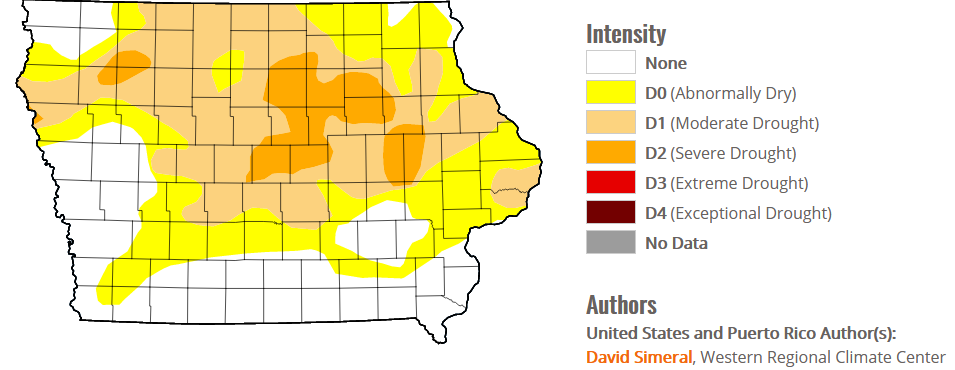CLICK HERE for the latest market quotes from the Iowa Agribusiness Network!
CLICK HERE for the latest market quotes from the Brownfield Ag News Network!
CLICK HERE for the latest market quotes from the Iowa Agribusiness Network!
CLICK HERE for the latest market quotes from the Brownfield Ag News Network!
(Atlantic, Iowa) – The Atlantic Parks and Recreation Department is putting on a 2nd, Adult Art in the Park event. It’s set to take place 6-p.m. September 25th, in the Kiddie Korral shelter at Sunnyside Park. Parks and Rec Director Bryant Rasmussen said “The first time we did this, it received a great response, and so we are working on planning new activities for this upcoming time.”
Additional information will be released as it becomes available. 
Cass County: Corn $5.24 Beans $12.29
Adair County: Corn $5.21 Beans $12.32
Adams County: Corn $5.21 Beans $12.28
Audubon County: Corn $5.23 Beans $12.31
East Pottawattamie County: Corn $5.27 Beans $12.29
Guthrie County: Corn $5.26 Beans $12.33
Montgomery County: Corn $5.26 Beans $12.31
Shelby County: Corn $5.27 Beans $12.29
Oats $4.17 (always the same in all counties)
(Radio Iowa) – Congressman Randy Feenstra, a Republican from Hull, says NASA research on what’s called “sustainable aviation fuel” should examine the use of biofuels for airplanes and spacecraft. “When I questioned Energy Secretary Jennifer Granholm in our committee meeting in May, she told me directly that she believes biofuels and biofuel technologies have an extremely bright future in sustainable aviation fueling,” Feenstra says.
Sustainable Aviation Fuel — sometimes called biojet fuel — is a crop based alternative to jet fuel made only from petroleum. “This cleaner, more affordable of powering transit and lowering emissions in NASA’s future of clean air transportation is extremely essential and is needed,” Feenstra says.
During a U.S. House subcommittee meeting Thursday, Feenstra proposed and the panel approved adding language to House Democrats’ infrastructure plan that will require NASA research and development of “sustainable aviation fuel” to include biofuels. Also Thursday, the White House invited representatives of the ethanol and biodiesel industry to a discussion about wider use “sustainable aviation fuel.”
(Radio Iowa) – Iowa farmers who want to enroll in either of the two major U-S-D-A conservation programs have until month’s end to submit their paperwork. Kate Hansen, a policy associate with the Center for Rural Affairs in Nevada, says the deadline is October 1st. “It’s for both the Conservation Stewardship Program and the Environmental Quality Incentives Program,” Hansen says. “These are what we call working lands conservation programs. They’re administered by USDA’s Natural Resources Conservation Service and these are programs that help you implement conservation practices while you’re still working the land.”
Last year, Iowa farmers signed more than 12-hundred contracts for the two programs, known as C-S-P and EQIP. Hansen says the programs are similar but there are key differences. “EQIP contracts are typically more focused on a particular resource concern or maybe a singular practice,” she says. “CSP is a program designed to be operation-wide, so, a farmer in a CSP contract is going to be implementing multiple practices over a five-year period and addressing different parts of their operation.”
Farmers who are interested in signing up for these programs should contact the Natural Resources Conservation Service in their county.
(Radio Iowa) – Iowa Agriculture Secretary Mike Naig says to achieve the goal of expanding existing Iowa meat lockers and getting new ones established, more people need to be trained as butchers. “You can’t just walk in off the street and automatically go to work,” Naig told Radio Iowa. “There’s training that’s required.”
A few college-level programs in the state offer instruction in meat processing, but Naig said more training programs, like apprenticeships, are needed. “There is a really good meat science program at Iowa State, but that’s a four year or an advanced degree and there’s a place for that from a management perspective or if you’re looking at food safety or specialty products….There’s a few community colleges with meat science programs as well, for a two-year program,” Naig said. “And then we think that there are folks who don’t need either of those and, really, what they need to do is come into a meat locker and do an apprenticeship.”

The Artisanal Butchery Task Force. (Ag Dept photo.)
Naig is chairman of the Artisanal Butchery Task Force, a temporary group created by a state law passed this spring. The group held its first meeting this week. “What we saw in the last year, year and a half is that the small meat locker was incredibly busy and we think there’s a tremendous opportunity for that to expand,” Naig said, “…so I think what we try to look at, then, is what can we do to try to have an impact.”
The legislature set aside $750 thousand worth of state grant money to help small meat lockers expand. Naig said the demand is there, from the consumer end. He’s heard from cattle producers who have potential customers for their beef, but can’t find a meat locker to break it down and package it. “It builds on a great Iowa brand for meat, direct to consumer and I think even branded products that end up in grocery stores and in restaurants is a good thing, too,” Naig said. “To me there’s just tremendous opportunity that also, potentially, can bring more cattle into the state.”
Naig is also lobbying the USDA to make more Iowa meat lockers eligible for the $500 million in federal grants that will be available. A meat processor must be federally-inspected or enrolled in a USDA program to ship meat across state lines to qualify. Naig said about half of Iowa’s 250 meat lockers are state inspected and under current rules would be ineligible for the federal grants.
(Williamsburg, Iowa) – An arson investigation at a large park led state conservation officers to an Iowa man. According to the Iowa Department of Natural Resources, 49-year-old Jereme Goltz, of Williamsburg, faces charges including two counts of third-degree arson, felony possession of a controlled substance- methamphetamine (3rd or subsequent offense), and littering following a two-month long investigation by Iowa Department of Natural Resources conservation officers.
During the months of July and August, DNR officials noticed an uptick in the number of illegal fires being set in parking lots, fields, and woodlands located within the 14,000-acre Hawkeye Wildlife Area. The fires damaged trees, fields, and parking lot posts and destroyed multiple hay bales owned by a farmer leasing a portion of the state land.

Jereme P. Goltz
As a result of the investigation, DNR conservation officers, along with the Iowa Department of Criminal Investigation and the Iowa State Patrol executed a search warrant at Goltz’s residence in Williamsburg. There, officers seized electronics, evidence relating to the fires, as well as methamphetamine and drug paraphernalia.
In 2019, Goltz led an Iowa conservation officer in a vehicle pursuit at the Hawkeye Wildlife Area. During the chase, Goltz left his vehicle and fled on foot into flood waters of the Iowa River where he climbed a tree. A lengthy rescue effort by Iowa DNR officers, the Johnson County Sheriff’s Department, the Iowa State Patrol and local fire departments to remove Goltz from the tree. Goltz was charged and convicted of eluding, carrying weapons, and possession of methamphetamine.
The latest U.S. Drought Monitor (USDM) data released Thursday, indicates this past week saw continued improvement in conditions across drought-stricken areas of the Central and Northern Plains states as well as in Iowa and Minnesota, where light-to-moderate rainfall accumulations were observed. On this week’s map, widespread one-category improvements were made in drought-stricken areas in northern Iowa and western Minnesota, which received another round of beneficial precipitation this week. In those areas rainfall accumulations ranged from 1 to 4 inches. In areas of northern Iowa and southern Minnesota, percentage of normal precipitation has ranged from 150% to 300% of normal for the last 30-day period.
Likewise, light rainfall this week led to trimming back of small areas of Moderate Drought (D1) in northwestern Illinois and west-central Indiana. Conversely, dry conditions during the past 90-day period led to slight expansion of areas of Severe Drought (D2) in northern Wisconsin as well as areas of Moderate Drought (D1) in Upper Peninsula Michigan.
In the immediate KJAN listening area, the Drought Monitor map shows Abnormally dry conditions remain over most of Cass, Adair, Audubon, Montgomery and Madison Counties, along with small sections of Mills, Adams, Fremont and Page Counties. Under those conditions, corn shows drought stress and the soil is dry The southeast quarter of Guthrie and most of Dallas County, is in a Moderate Drought. In a moderate drought: Soybeans abort pods; corn test weights are struggling; Grasses are brown; more grass fires occur; burn bans are issued, and pond levels decline.
The NWS Precipitation Forecast calls light precipitation accumulations (generally under 1 inch) during the week ahead.
(Radio Iowa) – Congresswoman Cindy Axne, a Democrat from West Des Moines, says the initial draft of the Democrats’ infrastructure plan in the U.S. House now reserves a billion dollars to promote the use of ethanol and biodiesel over the next eight years. “To issue grants directly to fuel retailers so that they can convert their existing pumps to deliver higher blends of ethanol and biodiesel,” Axne says. “They can install new pumps or related infrastructure, retrofit terminal operations, etc., so that they can carry more ethanol and biodiesel.”
Axne says it will be quite some time before electric models make up the majority of vehicles in use in America and biofuels are a greener alternative to gasoline AND to hybrid electric vehicles with a liquid fuel back-up. “There are multiple sectors of transportation that should also look to other opportunities, so this is a win-win,” Axne says. “This puts money in the pockets of Iowans while literally reducing our greenhouse gas emissions.”
A recent study led by a Harvard University environmental health professor found carbon and other greenhouse gas emissions from corn-based ethanol were 46 percent lower than from gasoline. Axne says she’s pretty confident the billion dollars for biofuels will stay in the infrastructure package, but she concedes it hasn’t been an easy fight to get it included in the initial draft.
“I’ve been handing out flyers in, literally, the chambers, educating people about biofuels. We’ve been hammering this thing home and, I think it sunk in that: ‘Listen, as we move towards this, let’s not forget a tool that really can move us in the right direction immediately,'” Axne says, “and that’s biofuels.”
The bill, which Democrats call their Build Back Better plan, will be considered in the U.S. House Agriculture Committee today (Friday).
(Radio Iowa) – Biden Administration officials say the nation’s four major meatpackers are engaging in profiteering during the pandemic and generating record or near-record profits this year. U-S Ag Secretary Tom Vilsack says it’s time to hold meatpackers responsible for unfair practices. “Farmers are losing money on cattle, on hogs and poultry that they are selling at a time when consumers are seeing higher prices at the grocery store,” he says.
Vilsack and other members of the administration’s competitiveness council meet Friday to discuss ways to address consolidation in the industry. “I remember talking to a producer the other day in Council Bluffs and he said: ‘I don’t get this, Mr. Secretary. I just sold my cattle and I lost $150 a head, but the processor made $1800 a head,” Vilsack says. “How can that be?”
Legislation introduced in congress would require more disclosure of the prices meatpackers are paying private contractors. That may give independent livestock producers a better sense of what meatpackers are willing to pay for cattle, hogs and poultry. According to the National Meat Institute, consumers are paying higher prices for beef, pork, chicken and eggs because of a persistent and widespread shortage of workers in meatpacking plants.